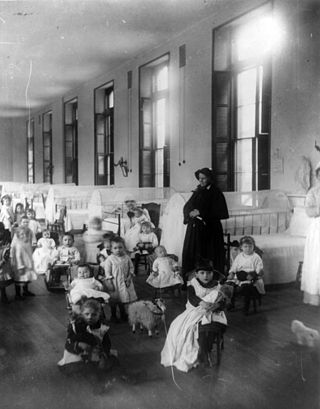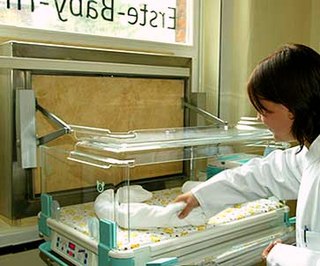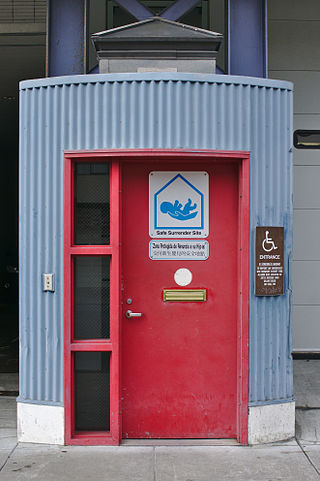Related Research Articles
Infanticide is the intentional killing of infants or offspring. Infanticide was a widespread practice throughout human history that was mainly used to dispose of unwanted children, its main purpose being the prevention of resources being spent on weak or disabled offspring. Unwanted infants were normally abandoned to die of exposure, but in some societies they were deliberately killed.

Adoption is a process whereby a person assumes the parenting of another, usually a child, from that person's biological or legal parent or parents. Legal adoptions permanently transfer all rights and responsibilities, along with filiation, from the biological parents to the adoptive parents.
Child abandonment is the practice of relinquishing interests and claims over one's offspring in an illegal way, with the intent of never resuming or reasserting guardianship. The phrase is typically used to describe the physical abandonment of a child, but it can also include severe cases of neglect and emotional abandonment, such as when parents fail to provide financial and emotional support for children over an extended period of time. An abandoned child is referred to as a foundling. Baby dumping refers to parents leaving a child younger than 12 months in a public or private place with the intent of terminating their care for the child. It is also known as rehoming when adoptive parents use illegal means, such as the internet, to find new homes for their children. In the case where child abandonment is anonymous within the first 12 months, it may be referred to as secret child abandonment.
Female infanticide is the deliberate killing of newborn female children. In countries with a history of female infanticide, the modern practice of gender-selective abortion is often discussed as a closely related issue. Female infanticide is a major cause of concern in several nations such as China, India and Pakistan. It has been argued that the low status in which women are viewed in patriarchal societies creates a bias against females.
Closed adoption is a process by which an infant is adopted by another family, and the record of the biological parent(s) is kept sealed. Often, the biological father is not recorded—even on the original birth certificate. An adoption of an older child who already knows his or her biological parent(s) cannot be made closed or secret. This used to be the most traditional and popular type of adoption, peaking in the decades of the post-World War II Baby Scoop Era. It still exists today, but it exists alongside the practice of open adoption. The sealed records effectively prevent the adoptee and the biological parents from finding, or even knowing anything about each other. However, the emergence of non-profit organizations and private companies to assist individuals with their sealed records has been effective in helping people who want to connect with biological relatives to do so.

Child protection is the safeguarding of children from violence, exploitation, abuse, and neglect. Article 19 of the UN Convention on the Rights of the Child provides for the protection of children in and out of the home. One of the ways to ensure this is by giving them quality education, the fourth of the United Nations Sustainable Development Goals, in addition to other child protection systems. To protect a child has to start from conception, even how the conception took place can affect the child's development. For proper child development to take place child protection must be put into consideration.

A baby hatch or baby box is a place where people can bring babies, usually newborn, and abandon them anonymously in a safe place to be found and cared for. This kind of arrangement was common in the Middle Ages and in the 18th and 19th centuries, when the device was known as a foundling wheel. Foundling wheels were taken out of use in the late 19th century, but a modern form, the baby hatch, began to be introduced again from 1952 and since 2000 has come into use in many countries, most notably in Pakistan where there are more than 300. They can also be found in Germany, where there are around 100, Czech Republic (76) and Poland (67).

Safe-haven laws are statutes in the United States that decriminalize the leaving of unharmed infants with statutorily designated private persons so that the child becomes a ward of the state. All fifty states, the District of Columbia, and Puerto Rico have enacted such statutes.

The history and culture of breastfeeding traces changing social, medical and legal attitudes to breastfeeding, the act of feeding a child breast milk directly from breast to mouth. Breastfeeding may be performed by the infant's mother or by a surrogate, typically called a wet nurse.
Neonaticide is the deliberate act of a parent murdering their own child during the first 24 hours of life. As a noun, the word "neonaticide" may also refer to anyone who practices or who has practiced this.
The Canadian Children's Rights Council Inc. (CCRC); is a non-governmental organization that is based in Toronto, Ontario, Canada and was founded in 1991. The CCRC describe themselves as a nonprofit, educational and advocacy organization dedicated to supporting the rights and responsibilities of Canadian children and providing critical analysis of governments' policies at all levels of government in Canada.
The Infanticide Act, often referred to as "Infanticide act of Gustav III" after its instigator Gustav III of Sweden, was a historical Swedish law, which was introduced in 1778 and in effect until 1917, with alterations in 1856.
Coin-operated-locker babies or coin-locker babies are victims of child abuse often occurring in Japan, in which infants are left in public lockers. There are two main variables that account for the differences in frequency and the type of these child abuse cases: social and economical. Predominantly neonates and male babies, the murder of infants became a form of population control in Japan, being discovered 1-3 months after death, wrapped in plastic and appearing to have died of asphyxiation. The presumption is that such lockers are regularly checked by attendants and the infant will be found quickly; however, many children are found dead. Between 1980 and 1990, there were 191 reported cases of infants which died in coin-operated lockers, which represents about six percent of all infanticides during that period.
There is very scarce information regarding women in pre-Islamic Arabia. Most of it originates from Hadith and historical traditions, pre-Islamic poetry, and early biographical accounts, or from conclusions from Qur'anic statements.
China has a history of female infanticide spanning 2,000 years. When Christian missionaries arrived in China in the late sixteenth century, they witnessed newborns being thrown into rivers or onto rubbish piles. In the seventeenth century Matteo Ricci documented that the practice occurred in several of China's provinces and said that the primary reason for the practice was poverty. The practice continued into the 19th century and declined precipitously during the Communist era, but has reemerged as an issue since the introduction of the one-child policy in the early 1980s. The 2020 census showed a male-to-female ratio of 105.07 for mainland China, a record low since the People's Republic of China began conducting censuses.
Female infanticide in India has a history spanning centuries. Poverty, the dowry system, births to unmarried women, deformed infants, famine, lack of support services, and maternal illnesses such as postpartum depression are among the causes that have been proposed to explain the phenomenon of female infanticide in India.

Intersex people are born with sex characteristics, such as chromosomes, gonads, or genitals, that, according to the UN Office of the High Commissioner for Human Rights, "do not fit typical binary notions of male or female bodies."
In a confidential birth, the mother provides her identity to authorities, but requires that her identity not be disclosed by the authorities. In many countries, confidential births have been legalized for centuries in order to prevent formerly frequent killings of newborn children, particularly outside of marriage.

Intersex people are born with sex characteristics, such as chromosomes, gonads, or genitals that, according to the UN Office of the High Commissioner for Human Rights, "do not fit typical binary notions of male or female bodies". "Because their bodies are seen as different, intersex children and adults are often stigmatized and subjected to multiple human rights violations".

Intersex people in Kenya face significant human rights violations, starting from birth. There are few protections from mutilation and non-consensual cosmetic medical interventions and no legislative protection from discrimination. Intersex persons may have difficulties in obtaining birth certificates and others forms of documentation.
References
- ↑ 최예니 (2017). Study on Confidential Birth and Safety Measures of Infants from Unmarried Mothers (Thesis). hdl: 10371/137993 .
- 1 2 3 Tanaka, Cintia T.; Berger, William; Valença, Alexandre M.; Coutinho, Evandro S. F.; Jean-Louis, Girardin; Fontenelle, Leonardo F.; Mendlowicz, Mauro V. (1 April 2017). "The worldwide incidence of neonaticide: a systematic review". Archives of Women's Mental Health. 20 (2): 249–256. doi:10.1007/s00737-016-0703-8. PMID 28013408. S2CID 4540971.
- ↑ Friedman, Susan Hatters; Resnick, Phillip J. (January 2009). "Neonaticide: Phenomenology and considerations for prevention". International Journal of Law and Psychiatry. 32 (1): 43–47. doi:10.1016/j.ijlp.2008.11.006. PMID 19064290.
- 1 2 Simmonds, Claire (2013). "An Unbalanced Scale: Anonymous Birth and the European Court of Human Rights". The Cambridge Law Journal. 72 (2): 263–266. doi:10.1017/S0008197313000391. JSTOR 24694002. S2CID 143104050. ProQuest 1373255306.
- 1 2 Beljestrand, Maria (2011). EN FÖRÄLDER BLIR TILL : Om fastställande och upphävande av föräldraskap och förhållandet till barnets bästa [A PARENT BECOMES: About establishing and revoking parenthood and the relationship to the best interests of the child] (Thesis) (in German).
- ↑ Marshall, Jill (2008). Personal Freedom through Human Rights Law?: Autonomy, Identity and Integrity under the European Convention on Human Rights. BRILL. p. 127. ISBN 978-90-474-1208-3.
- 1 2 Lefaucheur, Nadine (1 December 2004). "The French 'Tradition'of Anonymous birth: the lines of argument". International Journal of Law, Policy and the Family. 18 (3): 319–342. doi:10.1093/lawfam/18.3.319.
- ↑ Margaria, Alice (27 October 2014). "Anonymous Birth: Expanding the Terms of Debate". The International Journal of Children's Rights. 22 (3): 552–580. doi:10.1163/15718182-02203004.
- 1 2 Grylli, Chryssa; Brockington, Ian; Fiala, Christian; Huscsava, Mercedes; Waldhoer, Thomas; Klier, Claudia M. (1 April 2016). "Anonymous birth law saves babies—optimization, sustainability and public awareness". Archives of Women's Mental Health. 19 (2): 291–297. doi:10.1007/s00737-015-0567-3. PMID 26267063. S2CID 2037298.
- ↑ Willenbacher, Barbara (1 December 2004). "Legal transfer of French traditions? German and Austrian initiatives to introduce anonymous birth". International Journal of Law, Policy and the Family. 18 (3): 343–354. doi:10.1093/lawfam/18.3.343.
- ↑ Odièvre v. France [GC], no. 42326/98, ECHR 2003-III, ECLI:CE:ECHR:2003:0213JUD004232698